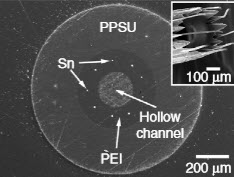New fibers can deliver optogenetic signals and drugs directly into the brain while allowing simultaneous electrical readout
January 30, 2015

SEM image of a probe incorporating nine tin (Sn) electrodes with within (poly(etherimide) (PEI) cladding, surrounding a hollow channel (shown filled to enable photography). The inset shows exposed electrodes after plasma etching of the poly(phenylsulfone) (PPSU) cladding. (Credit: Andres Canales et al./Nature Biotechnology)
MIT scientists have developed a new method of coping with the complexity of studying the brain.
They created probes containing biocompatible multipurpose fibers about 85 micrometers in width (about the width of a human hair).
The new fibers can deliver optogenetic signals and drugs directly into the brain, while allowing simultaneous electrical readout to continuously monitor the effects of the various inputs from freely moving mice.
The new fibers are made of polymers that closely resemble the characteristics of neural tissues — they are “soft and flexible and look more like natural nerves,” according to MIT assistant professor of materials science and engineering Polina Anikeeva — allowing them to stay in the body much longer without harming the delicate tissues around them.
Devices currently used for neural recording and stimulation, she says, are made of metals, semiconductors, and glass, which can damage nearby tissues during ordinary movement.
“It’s a big problem in neural prosthetics,” she says. “They are so stiff, so sharp — when you take a step and the brain moves with respect to the device, you end up scrambling the tissue” — forming scars and leading to neuronal death surrounding the electrode.
Flexible fiber-based probes
Her team used novel fiber-fabrication technology pioneered by MIT professor of materials science (and paper co-author) Yoel Fink and his team.
The key to the new technology for neural probes is making a larger-scale version, called a preform, of the desired arrangement of channels within the fiber — optical waveguides to carry light, hollow tubes to carry drugs, and conductive electrodes to carry electrical signals. These polymer templates are then heated until they become soft, and drawn into a thin fiber, while retaining the exact arrangement of features within them.

Scanning electron microscopy (SEM) cross-sectional image (a) of a multielectrode fiber with a diameter of 416 micrometers. Selective etching of the sacrificial poly(phenylsulfone) layer (b) exposes an array of tin electrodes (c) within the PEI cladding and reduces the diameter to 85 micrometers (d), which is similar to that of a human hair. (Credit: Andres Canales et al./Nature Biotechnology)
Combining the different channels in a single fiber, she adds, could enable precision mapping of neural activity, and ultimately treatment of neurological disorders, which would not be possible with single-function neural probes.
For example, light could be transmitted through the optical channels to enable optogenetic neural stimulation. Its effects could then be monitored with embedded electrodes. At the same time, one or more drugs could be injected into the brain through the hollow channels, while electrical signals in the neurons are recorded to determine, in real time, exactly what effect the drugs are having.
MIT | Multifunctional fibers communicate with the brain
Customizable toolkit for neural engineering
The system can also be tailored for a specific research or therapeutic application by creating the exact combination of channels needed for that task. “You can have a really broad palette of devices,” Anikeeva says.
The fibers could ultimately be used for precision mapping of the responses of different regions of the brain or spinal cord, Anikeeva says, and ultimately may also lead to long-lasting devices for treatment of conditions such as Parkinson’s disease.
John Rogers, a professor of materials science and engineering and of chemistry at the University of Illinois at Urbana-Champaign who was not involved in this research, says, “These authors describe a fascinating, diverse collection of multifunctional fibers, tailored for insertion into the brain where they can stimulate and record neural behaviors through electrical, optical, and fluidic means. The results significantly expand the toolkit of techniques that will be essential to our development of a basic understanding of brain function.”
The new technology is described in a paper appearing in the journal Nature Biotechnology, written by Anikeeva and 10 others. An earlier paper by the team described the use of similar technology for use in spinal cord research.
The work was supported by the National Science Foundation, the Center for Materials Science and Engineering, the Center for Sensorimotor Neural Engineering, the McGovern Institute for Brain Research, the U.S. Army Research Office through the Institute for Soldier Nanotechnologies, and the Simons Foundation.
Abstract for Multifunctional fibers for simultaneous optical, electrical and chemical interrogation of neural circuits in vivo
Brain function depends on simultaneous electrical, chemical and mechanical signaling at the cellular level. This multiplicity has confounded efforts to simultaneously measure or modulate these diverse signals in vivo. Here we present fiber probes that allow for simultaneous optical stimulation, neural recording and drug delivery in behaving mice with high resolution. These fibers are fabricated from polymers by means of a thermal drawing process that allows for the integration of multiple materials and interrogation modalities into neural probes. Mechanical, electrical, optical and microfluidic measurements revealed high flexibility and functionality of the probes under bending deformation. Long-term in vivo recordings, optogenetic stimulation, drug perturbation and analysis of tissue response confirmed that our probes can form stable brain-machine interfaces for at least 2 months. We expect that our multifunctional fibers will permit more detailed manipulation and analysis of neural circuits deep in the brain of behaving animals than achievable before.